Water Environment Solutions that Facilitate Ongoing Use of Water Resources
The water business in Japan is facing a wide variety of challenges, including a declining population dragging down customer numbers and revenue, rising demand for plant upgrades, and a fundamental rethink of water infrastructure resilience in the wake of the Great East Japan Earthquake. One approach to dealing with these is the use of public-private partnerships to outsource operations. There is scope for strengthening the foundations of the water business, which to date has primarily been operated by local government, by adopting practices that draw on the technical capabilities and expertise of the private sector to deliver benefits that include higher quality services and cost reduction. Drawing on the experience it has built up over many years of providing products to the water industry along with after-sales services and technology development, Hitachi intends to help create sustainable water businesses through the supply of solutions that are based on collaboration between the public and private sectors in forms such as private finance initiatives, design-build-operate projects, and full-service outsourcing.
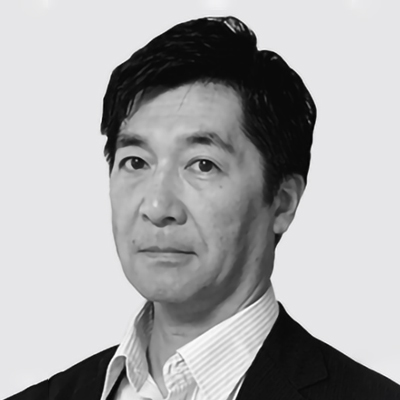
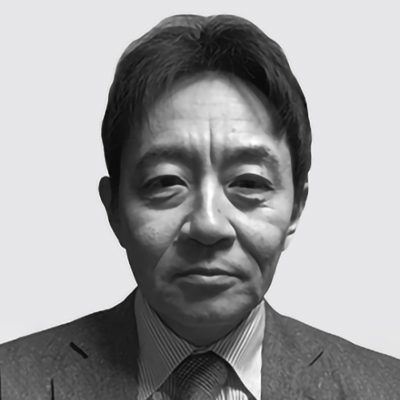
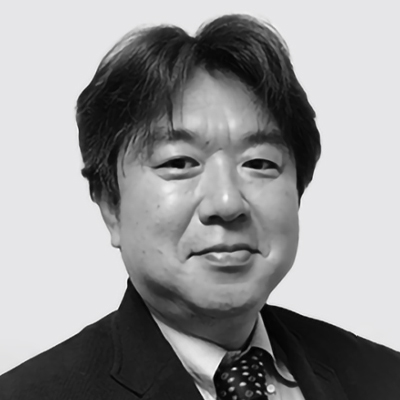
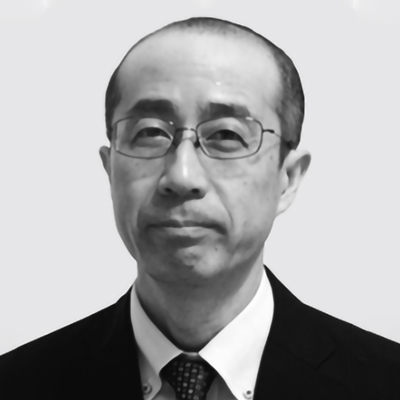
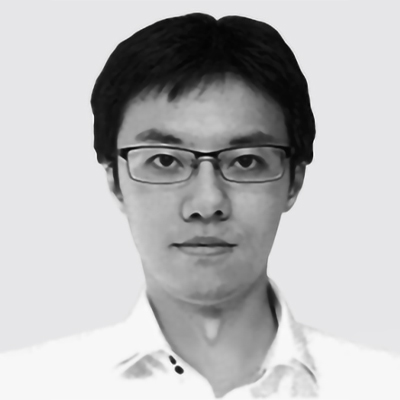
The population of Japan has been declining since its peak of approximately 128,080,000 in 2008(1). This is a major issue for the water industry, one that many utilities are already confronting, with consequences that include falling customer numbers and revenue, workforce aging, and problems with skills transfer resulting from staff shortages.
With the aging of water infrastructure, it is also anticipated that demand for plant upgrades will peak in the 2020s and 2030s, requiring funding and a planned program of upgrade work. Further complicating the environment in which the water industry operates are factors such as the fundamental rethink of how to manage emergencies and improve the earthquake resilience of plant that was prompted by the Great East Japan Earthquake(2).
Meanwhile, the Ministry of Health, Labour and Welfare in 2013 published its New Water Supply Vision that envisaged how the water industry should look in 50 to 100 years’ time and laid out policies for ensuring safety, resilience, and sustainability. One approach to achieving robust and reliable water operations under circumstances in which skills transfer and better management are also needed is that of public private partnerships (PPPs). Accordingly, the 2018 revisions to Japan’s Water Supply Act included measures to facilitate PPPs. By adopting practices that draw on the technical capabilities and expertise of the private sector to deliver such benefits as higher quality services and cost reduction, this is seen as a way of strengthening the foundations of the water business, which to date has primarily been operated by the public sector (local government).
This article presents examples of recent PPP projects undertaken by Hitachi and describes a digital solution service for operation and maintenance (O&M) support together with plans for its future deployment. This service utilizes advanced digital technologies such as augmented reality (AR), artificial intelligence (AI) and analytics based on the Internet of Things (IoT) to help achieve greater transparency in operational management and maintenance, reduce workloads, improve efficiency, and hand on expertise.
PPP business models can take various different forms. Examples include the partial outsourcing to the private sector of certain parts of the business such as operational management, full-service outsourcing that also encompasses a wide range of other management and maintenance activities, design-build-operate (DBO) arrangements in which a private-sector vendor not only designs and builds infrastructure but also handles its subsequent long-term maintenance and management, private finance initiatives (PFIs) that cover project funding, and concessions (see Figure 1).
Hitachi is currently involved in a wide range of projects that extend from partial outsourcing to DBO and PFI arrangements, its aim being to help create sustainable water infrastructure by drawing on the experience it has built up over many years of providing products and systems to the water industry along with after-sales services and technology development.
Figure 2 — Akagawa Koku Water Purification Plant and Overview of DBO Project The scope of the DBO project extends from upgrading mechanical and electrical equipment at the water purification plant to its operation and maintenance.
The scope of the DBO project extends from upgrading mechanical and electrical equipment at the water purification plant to its operation and maintenance.
Hakodate was the second city in Japan to install a modern water supply system, doing so in 1889. Since then, the city has built new water purification plants at Akagawa Teiku, Akagawa Koku, and Asahioka and now supplies water to approximately 260,000 people (as of March 2018), having inherited nine smaller water supply systems following a merger in 2004 that incorporated four outlying towns.
Hakodate City has now adopted a policy of selecting and fostering private-sector partners who are equipped with ingenuity and the ability to innovate in order to adapt to future changes in the water industry, thereby ensuring the long-term safety and security of the water supply together with more efficient plant operation. It was this decision that led to the DBO project described here.
Along with the upgrading of mechanical, electrical, and instrumentation equipment, primarily for the filtration tanks and overall monitoring and control system at the city’s main water purification plant at Akagawa Koku, the project also included a 20-year contract for the operation and maintenance of the upgraded plant as well as of other small water supply systems and the management of parks and the trees grown to protect water sources (see Figure 2). The project runs for 22 years from April 1, 2019 to March 31, 2041, with the contract being between Hakodate City Enterprise Department and a special-purpose company named Hakodate Aqua Solution, Ltd. that was established by Hitachi and two local partners. Work started on April 1, 2019.
In undertaking the project, Hitachi will combine its operational technology (OT) for operation and control and its experience and expertise in IT and other products acquired over many years as a full-service provider to the water industry with the strong technical capabilities of the other participating companies that are underpinned by their extensive experience with equipment design, production, and installation. The partners will draw on these capabilities to contribute to the maintenance and development of the water supply in Hakodate City through the provision of a comprehensive range of services for overcoming the future challenges that confront the city. The aim is also to deepen collaboration between the public and private sectors by consulting and working with the city on devising advanced technologies and services for the creation of digital solutions.
With the aims of supplying water to more people and expanding the areas where industrial water is available, the Ibaraki Prefecture Public Enterprise Bureau operates both domestic and industrial water supplies and has built 11 water purification plants to date (three for domestic supply, one for industrial supply, and seven supplying both domestic and industrial water). One of these is the Nakagawa Water Purification Plant, which commenced operation in 1966 and has a capacity of 122,680 m3/day. It is used exclusively to supply industrial water.
With the recruitment of operations and management staff having been made difficult by limitations on hiring, recent years have seen the establishment of an organizational structure that incorporates Ibarakiken Kigyou Kousha, a company set up by the Public Enterprise Bureau. Prompted by a subsequent reevaluation, the policy has since shifted toward the progressive adoption of full-service outsourcing with the aim of involving the private sector in those water purification plants where it is appropriate. As the result of a public tender, a joint venture between Hitachi and Akira Co., Ltd. was awarded a three-year contract running from 2016 to 2018 in which the two companies undertook operations and maintenance.
Along with aiming to utilize the advanced technologies built up by private sector companies to achieve more efficient operation of water purification plants through the integration of operations and maintenance, the contract also sought to develop and enhance operational technologies. What this meant in practice was a reduction in the frequency and duration of equipment shutdowns achieved by combining inspection and repair work while also coordinating installation work to minimize the impact on operations. The contract also sought to take advantage of the resources of group companies, including by utilizing the network of sites run by the joint venture companies to provide support in times of emergency, and by utilizing Hitachi’s own network infrastructure and data centers to move operations to the cloud. In the case of the cloud in particular, Hitachi has been working actively on proposals for the use of digital solutions that provide for the coordinated collection and management of operations and maintenance data and the use of analysis results in the business.
It resulted in a successful transfer of the expertise in operations and management that had been built up by the Public Enterprise Bureau and Ibarakiken Kigyou Kousha, a rapid response to equipment faults, and a lightening of the workload of Public Enterprise Bureau staff by taking over activities such as ordering and work supervision. The contract with the joint venture was renewed for another five years, with the second period having commenced in FY2019. Along with new energy efficiency measures in operations and maintenance work, the contract also involves the use of digital solutions to optimize inspections and help cut costs (see Table 1). Moreover, thanks to the transfer of expertise in operations and management, the joint venture will now take sole responsibility for operations and maintenance instead of handling this in partnership with Ibarakiken Kigyou Kousha as happened during the initial three-year contract (see Figure 3).
Hitachi has launched a cloud service to support O&M in the water industry that aims to reduce workloads while also improving transparency and efficiency and facilitating skills transfer (see Figure 4). The following sections describe how a cloud system for centralized data management provides a platform for using AI, the IoT, and other digital technologies to support the operation and maintenance of water treatment and distribution infrastructure.
Figure 5 — Remote Support for Work Using Camera-equipped Device Audio and video can be shared using a tablet or head-mounted display. Instructions can be supplied to the site from a remote location via bi-directional communications and a whiteboard.
Audio and video can be shared using a tablet or head-mounted display. Instructions can be supplied to the site from a remote location via bi-directional communications and a whiteboard.
Functions were developed to support equipment maintenance and equipment status assessment.
The maintenance support function uses AR to enable users to view manuals or details of previous faults and repairs on a tablet computer or head-mounted display, to guide them through particular tasks, or to receive instructions remotely from more experienced personnel (see Figure 5). Remote support via a tablet or other such device is of particular benefit during accidents or other incidents. It provides the means for on-site workers to send audio or video of what is happening from the camera on their device and then receive instructions in realtime from a supervisor or experienced worker sitting in front of a personal computer back at the office via bi-directional communications and a whiteboard. This function has the potential to improve workplace safety and work quality even for staff who lack experience of maintenance and inspection work.
The equipment assessment function facilitates condition-based maintenance (CBM)* by using past operational and inspection data to assess the condition of equipment. It uses adaptive resonance theory (ART) to learn from data collected during normal operation and outputs the results of the data analysis system in the form of a warning level. Rather than simply checking against thresholds for each data item, the system is able to identify problems or other changes in equipment condition at an early stage by detecting even small variations from normal in a combination of variables (see Figure 6).
The available functions also include a plant monitoring function that uses the IoT to collect data from sensors and monitor equipment operation, and a journal function that provides centralized management of digitally stored information such as how long equipment has been in service, records of faults and repairs, and inspection results entered into a device. The intention is to use these functions in tandem to achieve better and more efficient operation and maintenance as well as efficient asset management.
Figure 6 — Equipment Condition Assessment The function uses ART to assess equipment condition. The aim is to enable CBM through the early detection of changes in pumps or other plant.
The function uses ART to assess equipment condition. The aim is to enable CBM through the early detection of changes in pumps or other plant.
Functions are being developed for using AI and analytics to make operations and management more efficient.
The plant operation support function is intended to facilitate skills transfer while also keeping distribution pumps and other equipment operating appropriately. It uses machine learning to identify operational constraints from plant data so as to obtain a better understanding of current operating practices that rely on the judgement of skilled workers. These constraints are then used in operations planning and to guide operators on how best to operate the plant (see Figure 7). The quality of its guidance was assessed by initially deploying the function on a system that requires the precisely coordinated operation of multiple sets of water intake and distribution pumps(3). The scope of equipment and processes was subsequently expanded to encompass the water purification plant, with an evaluation currently underway into how well the function works for operation and management, including of filtration tanks (see Figure 8).
A water quality prediction function supports the use of additives to achieve the target water quality and helps respond to problems of poor water quality. The function uses mathematical models of the chemical reactions and AI techniques to predict water quality at source and at hydrant based on the water purification plant and hydrant processes, water quality data, and other openly available information such as weather data. In the case of residual chlorine, it uses the reaction models together with monitoring data such as temperatures and the rate of chlorine addition to predict the levels at hydrants and the concentrations of disinfection by-products. The results are used as a basis for setting the chlorine dosage rate and the target values for different locations. Hitachi has also developed a function that uses AI to predict intake water quality that helps with water treatment and water intake management. This works by predicting the extent of turbidity following rain events and the incursion of saltwater during droughts. This is used for things like determining the flocculant dosing rate or assisting with river water quality surveys and the placing of restrictions on water intake (see Figure 9).
In the future, Hitachi intends to review the benefits of these functions at sites where digital solution services have been adopted to support O&M, and to utilize the knowledge acquired to help devise and commercialize new support functions.
Figure 7 — How Support is Provided for Plant Operation and for Operation Based on Acquisition of Expertise Operational constraints are identified by applying machine learning to actual data and this enables planning and operational guidance to be provided at a level similar to that of an experienced worker. This helps address the problem of skills transfer and assists plant operation when operators are in short supply.
Operational constraints are identified by applying machine learning to actual data and this enables planning and operational guidance to be provided at a level similar to that of an experienced worker. This helps address the problem of skills transfer and assists plant operation when operators are in short supply.
Figure 9 — Water Quality Prediction Using AI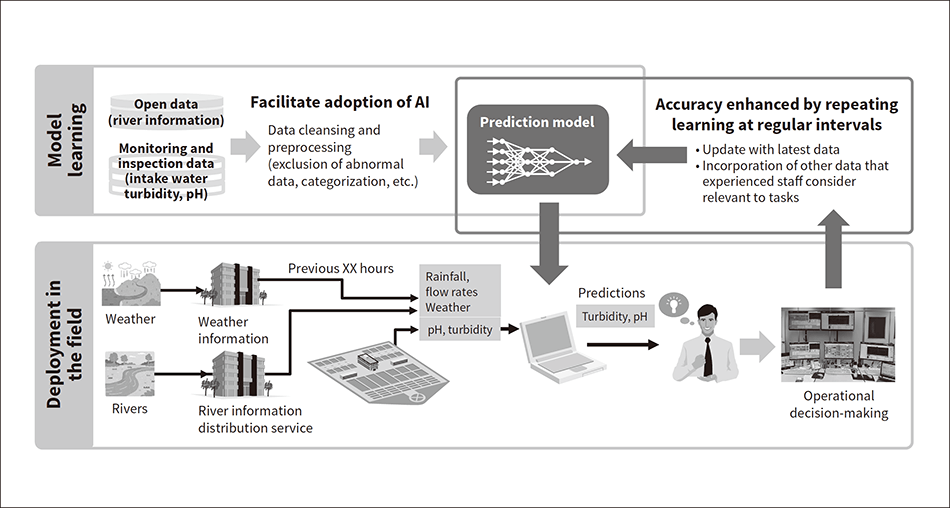 This assists quick and accurate operational decision-making by providing water quality predictions based on information such as river flows and monitoring and inspection data.
This assists quick and accurate operational decision-making by providing water quality predictions based on information such as river flows and monitoring and inspection data.
This article has described examples of public-private solutions for the water industry in which Hitachi is involved and the technologies used to support this work. In the future, Hitachi intends to help make water supplies sustainable and to improve services by becoming a “best partner” for water utilities through the supply of water industry solutions.